My First Watercooled PC
I built my first Watercooled_PC 8 years ago. I wanted to build something most of my peers would cringe at; that's combining electrical components with water. At the time I had no interest in overclocking or reducing fan noise I just wanted to see if it could be done. There were some companies that provided processor cooling blocks but nothing else. The remaining components I would have to acquire myself. Fortunately the rest of the required parts were easily obtained.
I decided to buy the best water pump I could find. Since this part is the heart of the entire cooling system, I wanted to make sure it did not failure prematurely. I found that Eheim makes a very good pump. I have had one for 8 years now and never had any problems. Danger Den was my cooling block supplier. They have since increased their inventory with entire kits, video card and chipset waterblocks and radiators. They supplied the waterblock, mounting hardware and thorough instructions.
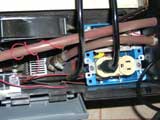
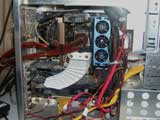
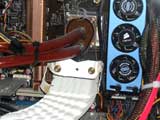
The radiator is an aftermarket tranny cooler I found in a junkyard costing me $10. The reservoir is a square plastic outdoor grade electrical box I bought at Lowes for $5. The fan is an AC fan I bought at Jameco for less than $10. The enclosure is a plastic file case I found at Walmart for less than for $10. I also included a dimmer switch in this design because I was not sure how loud the fan would be and wanted the ability to dial down its speed. I also wanted to include a relay, which would automatically turn the cooling system on when the computer boots up. I decided to hold off on the relay for a later design; a decision I would come to regret later.
I used a hard poly pipe for most of the design, but made a soft pipe transition where the pipe enters the PC case itself. I was worried that the hard pipe would put an undesired pressure on the waterblock causing it to shift it away from the processor. When I pick up the computer to move it to a different location the soft pipe going through the case remains still. I also chose not to use soft pipe throughout the entire design because I did not want a scenario where the pipe collapses and prevents water from circulating.
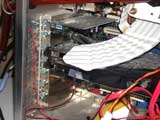
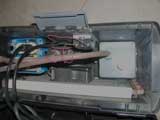
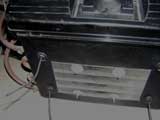
The original design had a simple switch on the cooler case and would be turn on before the computer was booted up. This worked for about a year until one day I inadvertently shut down the computer then shut off the cooler and left the house. What I didn't know was that the computer failed to shut down and ran until it fried the processor. It got so hot that the waterblock, which is a two-piece unit soldered together, melted the solder away from the block.
The solution is of course a relay. I ran a wire from the PC along the length of pipe into the cooler case and connected to a relay, which activates when the computer gets turn on. Another design problem here is that the cooler case has its own electrical plug, so if I neglect to plug in the cooler case the relay won't do anything for me. I of course make sure this does not happen, but it is far from bulletproof. I did have initial reservations with putting a waterblock over my expensive video card. My solution was to take a plastic gutter downspout elbow and cut it down to fit under the waterblock and over the video card. Fortunately I have never had to test it yet.